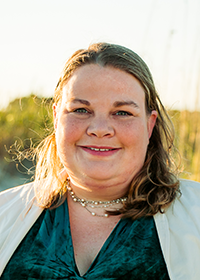Name 
Laura Black
School & School System Where You Work
Rocky Point Elementary School, Pender County Schools
Number of Years Teaching
18
Teaching Area(s)
Orchestra, Elementary
Grade Level
Elementary
What do you love most about teaching music?
I love seeing the joy on students’ faces when they’re introduced to a new song or instrument! Each new experience opens up a world of opportunities, and my job is just to guide students as they explore all of the possibilities that are available to them. It’s magical!
Who inspired you to be a music educator and how did they inspire you?
My mom, who was an educator, inspired me to go into education, but it wasn’t until 6th grade when I started playing the violin that I realized my path would be music education. My first orchestra teacher, Jane Tierney, helped nurture my passion, and my HS orchestra teachers, Linda Figart and Phil Singleton, offered me leadership opportunities in the orchestra as I confirmed that music education was my calling.
What did you need the most when you started teaching?
I needed a community (and I still do!). As a beginning teacher, there are so many things you don’t learn in college, like how to fundraise or manage all the different types of classroom behaviors. Having a community of fellow music educators gave me the opportunity to learn and work out solutions to any problems or uncertainties I was facing. I needed this support in a whole new way when I switched from teaching orchestra to teaching general music. At that point in my career, I had 8 years of teaching experience, but I was completely unfamiliar with elementary music curriculums. Having experienced elementary music teachers, both locally and through social media, really helped me gain my footing so I could become an effective elementary music teacher.
Describe the biggest challenge to teaching music education and how you have worked to overcome this challenge?
I think the biggest challenge is advocacy. Music education is so different than it was 20 years ago, and our families and stakeholders don’t realize what music classrooms look like today. I feel this is especially true in elementary music classrooms. My classroom is full of instruments and movement and exploration, not just sitting in a circle and singing songs. I’ve overcome this by using social media and YouTube to share pictures and videos of what goes on in our classes; this gives my stakeholders an idea of what their students are experiencing. I’ve also presented concerts that include instruments, movement, and children’s literature, and I have held ‘informances’ during the school day so that parents can join their student’s music class for a day.
Outside of our school community, I’ve made sure that our district leaders and superintendent know that quality music education is taking place at my school, and that our music education programs need their support. Last year, we began sending elementary groups to sing at the beginning of the Board of Education meetings, which has greatly increased our visibility.
How do you advocate for your program?
I mostly answered this in the previous question.
What is one piece of advice you would give to beginning teachers?
Reach out for help. It doesn’t mean that you’re a bad teacher or that you’re weak – it’s actually the opposite. Good teachers are constantly learning and reflecting; if you stay in your own little bubble, you won’t grow in your profession. There are so many organizations that offer mentorship programs (NCMEA’s program is great!), there’s a teacher in your building who is ready to help with the day-to-day logistics, and you can even build a network of online music educators. Just know that you’re not alone!
How do you build relationships with students and parents?
I think one of the most effective things I do is to communicate frequently through our school’s social media and YouTube channels. Families love to see what their students are learning in class; it doesn’t have to be a polished performance because they already see that at concerts. I also have ‘informances’ once a year, when I invite families to join their student’s music class. This gives parents an opportunity to learn alongside their student, experiencing the joy that their student experiences every week when they come to music.
